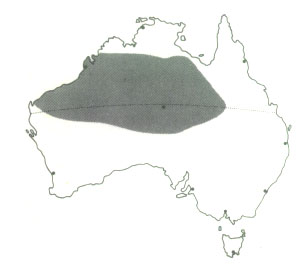![]()
 |
 |
DISTRIBUTION: Locally common in rocky gorges and stony hillsides on Spinifex plains in interior; reaches coastal dunes in Western Australia. |
Painted Firetail pair (male is on the left) |
Distribution Map |
|
IDENTIFICATION. LENGTH = 100 mm MALE: Crown and back pale brown; rump and upper tail-coverts scarlet; tail brown. Lores, forehead, face, chin and upper throat scarlet. Front of neck, breast, belly and flanks black with white spots; centre of belly scarlet; undertail-coverts black. Eye white; upper mandible black with red tip, lower red with blue base; legs with pink-brown. FEMALE: Scarlet limited to face and small patch on belly. IMMATURES: Similar to female but duller. No scarlet on head and breast; bill black above, grey below.
|
NESTING. Breeding months vary, depending on rainfall. Nest globular, with no entrance tunnel, 110 mm long, 110 mm high and 130 mm wide. Nest platform of earth stones and bark; outer wall of twigs , bark, rootlets and Spinifex stalks; inner walls of soft grass stems and lined with hairy seeds and feathers; placed in Spinifex grass. Eggs: three or four; white; 14 mm X 11 mm.
|
|
FORMS.
|
|
AVIARY BREEDING. NESTING TYPES: I have found that these birds will nest almost anywhere although they will usually prefer a nest box including parrot nest boxes rather than build a nest of their own. I have seen these birds build nests in tea tree branches and planted trees but very rarely. Best results have been from boxes 150 mm square X 125 mm high with a 40 mm access hole in the front and a small landing platform just below the entrance. (See the Plans page for more information) FEEDING: A general finch mix is ideal for this bird. Birds will also readily take seeding grasses and live food. However I have had seen these birds breed successfully with just a mixed seed diet. Egg and biscuit will also be taken readily. OTHER FEEDS: Cuttlebone and shell grit should be supplied at all times. SPECIAL REQUIREMENTS: There are no special requirements for this species. However care should be taken not to house this species with the Masked Finch or the Long-tailed Finch or any of the subspecies.
|
| AVIARY SPECIFICATIONS. | WIRE MESH: 1/4 x 1/4 or 6 mm x 6 mm | Also known as mouse wire |
| LENGTH: 11ft 6in or 3575 mm | WIDTH:6ft or 1800 mm | HEIGHT: 8ft or 2400 mm |
| SHED: Half the aviary should be enclosed.
These are recommendations only and individual breeders may have different dimensions and specifications.
|
FLOOR: I have found a dirt floor preferable. |
OTHER: |
|
BREEDER SUBMISSIONS. |
|
| From |
![]()
Author
P Campbell
Copyright © 2002 P. Campbell. All rights reserved.
Revised: April 23, 2002
.